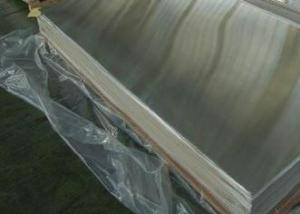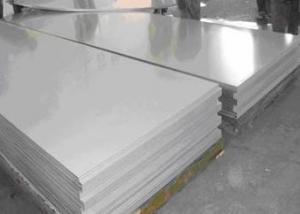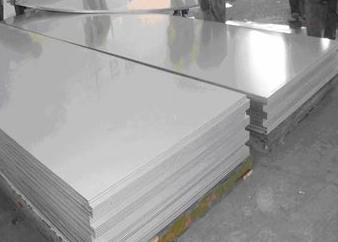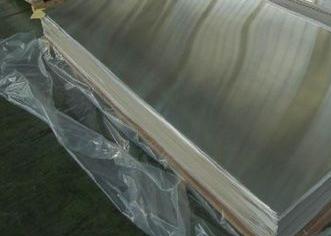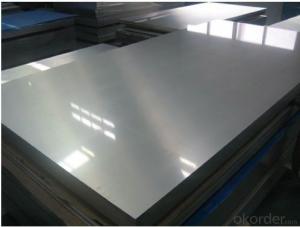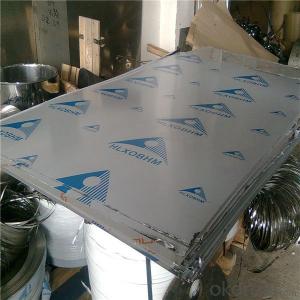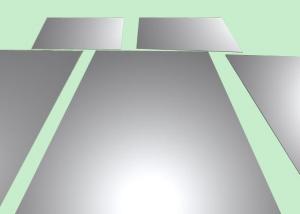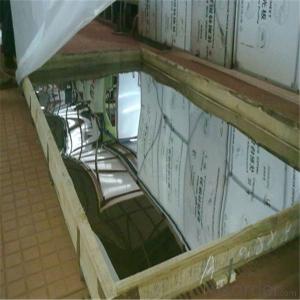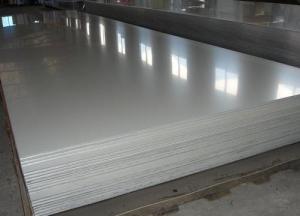SUS304L Stainless Steel Sheet
- Loading Port:
- China Main Port
- Payment Terms:
- TT or LC
- Min Order Qty:
- 1 Ton m.t.
- Supply Capability:
- 1000 Tons Per Month m.t./month
OKorder Service Pledge
OKorder Financial Service
You Might Also Like
304L stainless steel sheet
1. Chemical composition
|
C |
Si |
Mn |
P |
S |
Ni |
Cr |
|
Max0.03 |
Max1.00 |
Max2.00 |
Max0.045 |
Max0.03 |
9.0-13.0 |
18.0-20.0 |
2. Mechanical properties
|
Yield Strength |
Tensile |
Elongation |
Hardness (HV) |
Hardness (HRB) |
|
≥175 |
≥480 |
≥40 |
≤200 |
≤90 |
3. Standard: AISI, ASTM, GB, EN, DIN, JIS
4. Surface: 2B, NO.1, BA, NO.4, Hairline, SB, Mirror finish, Anti-skid, Cherkered etc.
5. Size: Thickness: 0.3-3mm (cold rolled), 3-40mm (hot rolled)
Width: 1000mm or 1219mm or 1240mm for cold rolled, 1500mm for hot rolled.
Length: As customers' request.
6. MOQ: 1 Ton
7. Payment terms: T/T or L/C
8. Packing: Seaworthy package with wooden or Iron pallets with the paper and the steel strip, or as customers' request.
9. Delivery time: Usually about 7 days after we confirming the order, or according to your quantity.
If you have any question or demand, pls feel free to contact me.
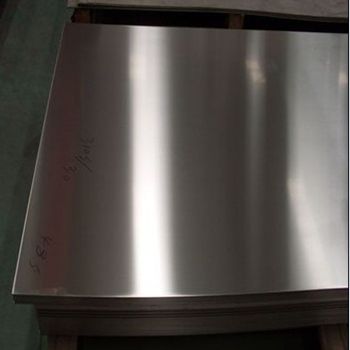
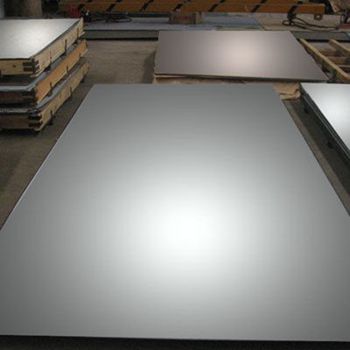
- Q: Can stainless steel strips be used in musical instruments?
- Yes, stainless steel strips can be used in musical instruments. They are commonly used in the construction of instruments such as guitars, drums, and pianos for various purposes, including providing structural support, enhancing tonal qualities, and improving durability.
- Q: How do stainless steel strips perform in low temperature environments?
- Stainless steel strips perform exceptionally well in low temperature environments due to their inherent properties such as high strength, corrosion resistance, and toughness. They are capable of maintaining their structural integrity, durability, and resistance to brittleness even in extremely cold temperatures.
- Q: Are stainless steel strips resistant to chloride stress corrosion cracking?
- Generally, stainless steel strips exhibit resistance to chloride stress corrosion cracking. The corrosion resistance properties of stainless steel are widely recognized, encompassing resistance to chloride stress corrosion cracking. This is attributed to the abundance of chromium in stainless steel, which generates a protective oxide layer on the material's surface, prohibiting the infiltration of chloride ions and subsequent corrosion. Nevertheless, it is vital to acknowledge that the resistance to chloride stress corrosion cracking may fluctuate depending on the specific stainless steel type and grade, as well as the environmental conditions in which the material is exposed. Thus, it is always advisable to refer to the manufacturer's specifications and guidelines to ensure the appropriate stainless steel grade is chosen for the intended application.
- Q: Can stainless steel strips be used in automotive exhaust systems?
- Automotive exhaust systems can indeed utilize stainless steel strips. Due to their exceptional corrosion resistance and durability, stainless steel is widely favored for exhaust systems. Its ability to withstand extreme temperatures and harsh conditions makes it an excellent fit for the demanding environment of an exhaust system. Stainless steel strips, renowned for their strength and resistance to rust and corrosion, are frequently employed in the construction of exhaust pipes, mufflers, and other components. Furthermore, stainless steel strips are easily moldable, weldable, and shapeable, enabling them to cater to the precise needs of an exhaust system, thus rendering them an ideal option for automotive applications.
- Q: Can stainless steel strips be used in the water treatment industry?
- Yes, stainless steel strips can be used in the water treatment industry. Stainless steel is highly resistant to corrosion and can withstand exposure to water, making it suitable for various applications in water treatment such as filtration systems, tanks, pipes, and fittings. Its durability and hygienic properties make it a preferred choice for ensuring clean and safe water treatment processes.
- Q: What are the factors affecting the strength of 111 stainless steel strips?
- The strength of 111 stainless steel strips can be influenced by various factors. These factors include the composition of the steel, the heat treatment process, the amount of cold working applied, the grain size, the surface finish, the environmental conditions, the manufacturing process, and the design considerations. Regarding composition, the strength of the steel can be greatly impacted by the chemical composition, particularly the levels of elements such as nickel, chromium, and molybdenum. Higher amounts of these elements generally result in increased strength. The heat treatment process used during manufacturing is another significant factor. Annealing, quenching, and tempering can alter the microstructure of the steel, leading to changes in strength. The amount of cold working or deformation applied to the steel during processing is also important. Cold working can enhance strength by introducing dislocations, but excessive cold working can cause brittleness. The grain size of the steel is another influential factor. Smaller grain sizes tend to result in higher strength due to increased grain boundaries, which hinder dislocation movement. The surface finish of the steel can affect its strength, particularly in terms of fatigue resistance. Smooth and polished surfaces tend to improve the material's fatigue strength. The environment in which the steel is used can impact its strength as well. Factors such as temperature, humidity, and exposure to corrosive substances can lead to degradation and reduced strength over time. The specific manufacturing process employed can also influence the strength of the steel. Variables such as rolling techniques, annealing processes, and cold reduction methods can all have an impact. The design of the steel, including factors like thickness, width, and the presence of surface defects or notches, can also affect strength. Proper design considerations should be made to ensure optimal strength and performance. It is important to note that these factors are interconnected, and changes in one factor can influence the others. Manufacturers and engineers must carefully consider all these factors to achieve the desired strength and performance of 111 stainless steel strips.
- Q: Can stainless steel strips be used in pulp and paper industries?
- Yes, stainless steel strips can be used in pulp and paper industries. Stainless steel is known for its excellent corrosion resistance, making it ideal for applications in industries where contact with moisture or chemicals is common, such as the pulp and paper industry. Stainless steel strips can be used for various purposes in this industry, including the production of paper machines and equipment, pulp screens, refining and washing systems, bleaching equipment, and paper handling systems. Stainless steel's durability and resistance to rust and corrosion ensure that the strips can withstand the harsh conditions and chemicals involved in pulp and paper processes, leading to longer equipment lifespan and reduced maintenance costs. Additionally, stainless steel is easy to clean and maintain, which is crucial in maintaining hygienic conditions required in the pulp and paper industry. Therefore, stainless steel strips are widely used in the pulp and paper industry due to their excellent properties and suitability for the industry's specific requirements.
- Q: What is the difference between hot-rolled and cold-rolled stainless steel strips?
- Hot-rolled and cold-rolled stainless steel strips refer to two different methods of manufacturing stainless steel strips, each with distinct characteristics and applications. Hot-rolled stainless steel strips are produced by heating stainless steel slabs or billets above their recrystallization temperature and then passing them through a series of rollers to achieve the desired thickness. This process results in a strip with a rough surface finish and a scaled or oxidized outer layer. Hot-rolled strips are known for their strength and durability, making them suitable for applications that require high tensile strength and resistance to deformation, such as structural components, automotive parts, and machinery. On the other hand, cold-rolled stainless steel strips are manufactured by taking hot-rolled strips and further processing them through a cold reduction mill. This involves passing the strips through a number of rollers at room temperature to decrease their thickness and improve their surface finish. Cold-rolled strips have a smoother, more polished appearance and a tighter dimensional tolerance compared to hot-rolled strips. They are commonly used in applications that demand a higher level of surface finish, precision, and flatness, such as consumer appliances, kitchenware, and decorative elements. Another significant difference between hot-rolled and cold-rolled stainless steel strips is their mechanical properties. Hot-rolled strips have a lower yield strength and higher ductility, which means they are more prone to deformation and can be easily shaped or formed. Cold-rolled strips, on the other hand, have a higher yield strength and lower ductility, making them less malleable but more resistant to deformation. This makes cold-rolled strips ideal for applications that require precise dimensions and tight tolerances. In conclusion, the main differences between hot-rolled and cold-rolled stainless steel strips lie in their surface finish, dimensional tolerance, mechanical properties, and applications. Hot-rolled strips are characterized by their rough surface finish, high strength, and suitability for structural applications, while cold-rolled strips have a smoother surface finish, tighter dimensional tolerance, and are often used in applications that demand precision and aesthetics.
- Q: Can stainless steel strips be used for decorative trims?
- Yes, stainless steel strips can be used for decorative trims. Due to their sleek and shiny appearance, stainless steel strips are often used to add a modern and stylish touch to various decorative applications, such as on furniture, appliances, or architectural elements.
- Q: How do stainless steel strips resist corrosion?
- Stainless steel strips resist corrosion due to the presence of chromium in their composition. When exposed to oxygen, a thin layer of chromium oxide forms on the surface of the steel, creating a protective barrier that prevents further oxidation and corrosion.
Send your message to us
SUS304L Stainless Steel Sheet
- Loading Port:
- China Main Port
- Payment Terms:
- TT or LC
- Min Order Qty:
- 1 Ton m.t.
- Supply Capability:
- 1000 Tons Per Month m.t./month
OKorder Service Pledge
OKorder Financial Service
Similar products
Hot products
Hot Searches
Related keywords
